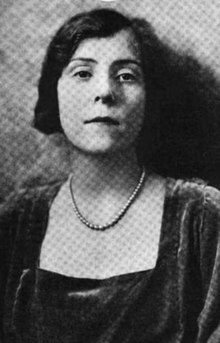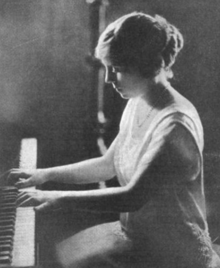Frances Nash Watson
Frances Nash Watson | |
|---|---|
 | |
| Born | Frances Nash July 8, 1890 Omaha, Nebraska, United States |
| Died | December 20, 1971 (aged 81) Charlottesville, Virginia, United States |
| Occupation | Pianist |
| Spouse | Edwin "Pa" Watson |
Frances Nash Watson (July 8, 1890 – December 20, 1971) was an American concert pianist and composer. In the 1920s, she was part of a musical trio with Elisabeth of Bavaria, Queen of the Belgians, and Albert Einstein. Later in life she was prominent in social and musical circles in Washington, D.C.
Early life
[edit]Frances Nash was born in Omaha, Nebraska and raised in New York City,[1] the daughter of Edward Watrous Nash and Catherine Barbeau Nash. Her father was a wealthy manufacturer.[2] She graduated from Mount Vernon Seminary, and studied piano in New York City with Bruno Oscar Klein, in Boston with Georges Longy, and in Europe with several musicians as a young woman.[3][4]
Career
[edit]
Nash made her concert debut in 1914, playing Chopin with the Berlin Philharmonic. Her American debut came in 1915,in Omaha,[1] before she toured with tenor George Hamlin in the central and western states that year.[5][6] She played recitals at New York's Carnegie Hall in 1916, and at Aeolian Hall in 1919 and 1923.[7][8] She also played in a string trio with cellist May Mukle and violist and composer Rebecca Clarke.[9] When 1918 concert dates were postponed because of the Spanish flu epidemic, she played outdoor patriotic programs at Camp Upton and elsewhere.[10]
While her husband was serving as a military attaché in Europe, she befriended Queen Elizabeth of Belgium; the two women shared a love of playing music, and they formed a trio with physicist Albert Einstein, playing for hours together.[3] Back in the United States after 1933, she played at the White House during the Roosevelt administration, and appeared as a soloist with the National Symphony Orchestra.[11] In her later years, she remained active in supporting musical organizations and events in Washington.[3]
Nash wrote “Canzonetta, d’Ambrosia" for piano, and played for the piano roll recording of that work and several others, for the American Piano Company (Ampico).[12][13]
Personal life
[edit]In 1920, in Paris, Nash married Edwin Martin "Pa" Watson,[14] who became a United States Army general and military attaché. The Watsons lived at Kenwood, on land once owned by Thomas Jefferson,[15] in a house designed by William Adams Delano.[3] Her husband died in 1945,[16] and she died in 1971, aged 81, in Charlottesville, Virginia.[3] Her grave is with her husband's grave, in Arlington National Cemetery. The Watsons' papers are in the University of Virginia Library.[17] Scrapbooks belonging to the Watsons are in the Thomas Jefferson Foundation Archives at Monticello.[15]
References
[edit]- ^ a b "Contemporary American Musicians No 59: Frances Nash". Musical America. 29: 27. March 22, 1919.
- ^ "Riches No Bar to Miss Nash's Artistic Career". Musical America. 22: 22. July 10, 1915.
- ^ a b c d e "Mrs. Frances Nash Watson, 81; General's Widow Was Pianist". The New York Times. December 22, 1971. ISSN 0362-4331. Retrieved September 30, 2022.
- ^ Pierre Key's Music Year Book. Pierre Key Publishing Corporation. 1925. pp. 320–321.
- ^ "Talent and Dollars". Musical Courier. 71: 14. July 28, 1915.
- ^ "Frances Nash, Pianist, Begins Her First American Tour". Musical America. 22: 30. October 30, 1915.
- ^ DJT (April 5, 1919). "Miss Nash Proves Artistry in Recital". Musical America. 29: 22.
- ^ "Frances Nash an Advocate of Education". Musical Courier. 87: 65. December 13, 1923.
- ^ Graham, Amy (December 12, 1919). "Trio Heard in Ensemble". Buffalo Evening News. p. 31. Retrieved September 30, 2022 – via Newspapers.com.
- ^ "Frances Nash Gives Interrupted Concert Dates to Patriotic Work". Musical America. 29: 11. November 16, 1918.
- ^ "Artist Yearns for this Section". The North Adams Transcript. January 3, 1935. p. 9. Retrieved September 30, 2022 – via Newspapers.com.
- ^ ""Canzonetta, d'Ambrosia," Frances Nash (Composer), Frances Nash (Pianist), 463183-G (Reference #)". Original Ampico Player Piano Rolls. Retrieved September 30, 2022.
- ^ American Piano Corporation (1925). A Catalogue of Music for the Ampico: A List of the Recordings of Pianists Whose Art is Thus Preserved for Present Day Music Lovers and for Posterity : Together with Short Biographies of Many of the Composers and Artists and Notes on the Music. pp. 131–132.
- ^ "Col. and Mrs. Watson at Fontainebleau". The Omaha Daily News. September 23, 1920. p. 8. Retrieved September 30, 2022 – via Newspapers.com.
- ^ a b "Edwin M. Watson and Mrs. Watson (Frances Nash) Collection". Thomas Jefferson Foundation ArchivesSpace. Retrieved September 30, 2022.
- ^ "Mrs. Watson dies at 81". Corpus Christi Caller-Times. December 22, 1971. p. 53. Retrieved September 30, 2022 – via Newspapers.com.
- ^ "A Guide to the Papers of Edwin M. Watson and of Frances Nash Watson, 9786 Watson, Papers of Edwin M. and of Frances Nash Watson 9786". University of Virginia Library. Retrieved September 30, 2022.
External links
[edit]- A 1922 recording of Frances Nash playing Saint-Saëns, "Etude en Forme de Valse", on an Ampico piano roll, at SoundCloud
- A recording of Frances Nash playing Sapellnikoff, "Elfin Dance" Op. 3, on an Ampico piano roll, on YouTube
